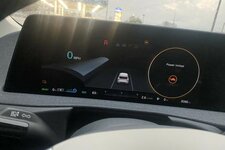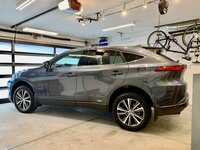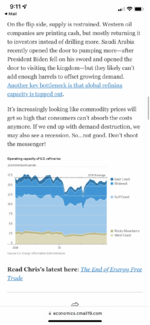Separately, I rented a Toyota Camry on a one-way rental from Annapolis up to Point Pleasant, NJ on Sat/Sun to go and pick up my new boat. The Camry only used 5 gallons to go about 200 miles -- that is around 40 MPG. 98% of it was freeway driving, and I'd say it was at reasonable speeds around 65-75 MPH the whole way. Still, double the mileage of my E500 that I drove on the same route, albeit at moderately higher speed.
Transiting the boat down on Sunday from New Jersey to Annapolis, it was a trip of around 200 nautical miles, give or take. Three fuel stops along the way, in Atlantic City, NJ; Cape May, NJ; and Bear, DE (in the Chesapeake & Delaware Canal). Total fuel cost was around $650 to do that trip.
The fuel burn rate (best I could calculate it) was around 1.2 nautical miles per gallon at speeds ranging from 15 to 30 knots, depending on the water along the way. Offshore in the Atlantic, the waves ranged 3-6 feet, and it was a decently calm day. Once I rounded Cape May, and got into the Delaware Bay, things got much calmer (1-2 foot waves), and I could cruise at a MUCH higher speed in the 25-30 knot range.
Atlantic City, NJ, coming into Kammerman's Marina for a $250+ fuel stop:
 Here is the Wall Street Journal article I mentioned above.
Here is the Wall Street Journal article I mentioned above.
I Rented an Electric Car for a Four-Day Road Trip.
I Spent More Time Charging It Than I Did Sleeping.
Our writer drove from New Orleans to Chicago and back to test the feasibility of taking a road trip in an EV. She wouldn’t soon do it again.
I thought it would be fun.
That’s what I told my friend Mack when I asked her to drive with me from New Orleans to Chicago and back in an electric car.
I’d made long road trips before, surviving popped tires, blown headlights and shredded wheel-well liners in my 2008
Volkswagen Jetta. I figured driving the brand-new
Kia EV6 I’d rented would be a piece of cake.
If, that is, the
public-charging infrastructure cooperated. We wouldn’t be the first to test it. Sales of pure and hybrid plug-ins doubled in the U.S. last year to 656,866—over 4% of the total market, according to database EV-volumes. More than half of car buyers say they want their next car to be an EV, according to recent Ernst & Young Global Ltd. data.
By the Numbers
Our reporter’s four-day, three-night EV road trip included many charging stops, little sleep—and less junk food than you might expect
- Miles driven: 2,013
- Number of charges: 14
- Total charging cost: $175
- Hours spent waiting to charge: 18
- Hours of sleep: 16
- Calories of junk food consumed (estimated): 1,465
- Giant chicken statues passed: 1
Oh—and we aimed to make the 2,000-mile trip in just under four days so Mack could make her Thursday-afternoon shift as a restaurant server.
Less money, more time
Given our battery range of up to 310 miles, I plotted a meticulous route, splitting our days into four chunks of roughly 7½-hours each. We’d need to charge once or twice each day and plug in near our hotel overnight.
The PlugShare app—a user-generated map of public chargers—showed thousands of charging options between New Orleans and Chicago. But most were classified as Level 2, requiring around 8 hours for a full charge.
While we’d be fine overnight, we required fast chargers during the days. ChargePoint Holdings Inc., which manufactures and maintains many fast-charging stations,
promises an 80% charge in 20 to 30 minutes. Longer than stopping for gas—but good for a bite or bathroom break.
The government is spending $5 billion to build a nationwide network of fast chargers, which means thousands more should soon dot major highways. For now, though, fast chargers tend to be located in parking lots of suburban shopping malls, or tethered to gas stations or car dealerships.

We hit the road with high hopes. Photo: Rachel Wolfe
Cost varies widely based on factors such as local electricity prices and charger brands. Charging at home tends to be cheaper than using a public charger, though some businesses offer free juice as a perk to existing customers or to entice drivers to come inside while they wait.
Over four days, we spent $175 on charging. We estimated the equivalent cost for gas in a Kia Forte would have been $275, based on the AAA average national gas price for May 19. That $100 savings cost us many hours in waiting time.
But that’s not the whole story.
Charging nuances
New Orleans, our starting point, has exactly zero fast chargers, according to PlugShare. As we set out, one of the closest is at a
Harley-Davidson dealership in Slidell, La., about 40 minutes away. So we use our Monday-morning breakfast stop to top off there on the way out of town.
But when we tick down 15% over 35 miles? Disconcerting. And the estimated charging time after plugging in? Even more so. This “quick charge” should take 5 minutes, based on our calculations. So why does the dashboard tell us it will take an hour?
“Maybe it’s just warming up,” I say to Mack. “Maybe it’s broken?” she says.
Over Egg McMuffins at
McDonald’s, we check Google. Chargers slow down when the battery is 80% full, the State of Charge YouTube channel tells us.
Worried about time, we decide to unplug once we return to the car, despite gaining a measly 13% in 40 minutes.
When ‘fast’ isn’t fast
Our real troubles begin when we can’t find the wall-mounted charger at the Kia dealership in Meridian, Miss., the state’s seventh-largest city and hometown of country-music legend Jimmie Rodgers.
When I ask a mechanic working on an SUV a few feet away for help, he says he doesn’t know anything about the machine and points us inside. At the front desk, the receptionist asks if we’ve checked with a technician and sends us back outside.
Not many people use the charger, the mechanic tells us when we return. We soon see why. Once up and running, our dashboard tells us a full charge, from 18% to 100%, will take 3-plus hours.
It turns out not all “fast chargers” live up to the name. The biggest variable, according to State of Charge, is how many kilowatts a unit can churn out in an hour. To be considered “fast,” a charger must be capable of about 24 kW. The fastest chargers can pump out up to 350. Our charger in Meridian claims to meet that standard, but it has trouble cracking 20.
“Even among DC fast chargers, there are different level chargers with different charging speeds,” a ChargePoint spokeswoman says.

A lot in Meridian, Miss., was filled with rusted-out fuel pumps and gas station signs. Photo: Rachel Wolfe
Worse, it is a 30-minute walk to downtown restaurants. We set off on foot, passing warehouses with shattered windows and an overgrown lot filled with rusted fuel pumps and gas-station signs. Clambering over a flatcar of a stalled freight train, we half-wish we could hop a boxcar to Chicago.
Missed reservations
By the time we reach our next station, at a
Mercedes-Benz dealership outside Birmingham, Ala., we’ve already missed our dinner reservations in Nashville—still 200 miles away.
Here, at least, the estimated charging time is only an hour—and we get to make use of two automatic massage chairs while we wait.
Salesman Kurt Long tells us the dealership upgraded its chargers to 54-kW models a few weeks earlier when the 2022 Mercedes EQS-Class arrived.
“Everyone’s concern is how far can the cars go on a charge,” he says. He adds that he would trade in his car for an EV tomorrow if he could afford the $102,000 price tag. “Just because it would be convenient for me because I work here,” he says. “Otherwise, I don’t know if I would just yet.”
A customer who has just bought a new
BMW says he’d consider an EV one day—if the price drops.

The giant chicken statue in Ardmore, Tenn.Photo: Rachel Wolfe
“You remember when the microwave came out? Or DVD players?” says Dennis Boatwright, a 58-year-old tree surgeon. “When you first get them the prices were real high, but the older they are, the cheaper they get.”
When we tell him about our trip, he asks if we’ll make it to Chicago.
“We’re hoping,” I say.
“I’m hoping, too,” he says.
A giant chicken
After the Birmingham suburbs, our journey takes us along nightmarish, dark mountain roads. We stop for snacks at a gas station featuring a giant chicken in a chef’s costume. We lean heavily on cruise control, which helps conserve battery life by reducing inadvertent acceleration and deceleration. We are beat when we finally stumble into our Nashville hotel at 12:30 a.m.
To get back on schedule, we are up and out early, amid pouring rain, writing the previous day off as a warm-up, an electric-car hazing.
For the most part, we are right. Thanks to vastly better charging infrastructure on this leg, all our stops last less than an hour.
It isn’t all smooth sailing, though. At one point we find ourselves wandering through a
Kroger, sopping wet, in search of coffee after wrestling with a particularly finicky charger in the rain. By this point, not once have we managed to back in close enough to reach the pump, or gotten the stiff cord hooked around the right way on the first try.
In the parking lot of a Clarksville, Ind.,
Walmart, we barely have time for lunch, as the Electrify America charging station fills up our battery in about 25 minutes, as advertised.
The woman charging next to us describes a harrowing recent trip in her Volkswagen ID.4. Deborah Carrico, 65, had to be towed twice while driving between her Louisville, Ky., apartment and Boulder, Colo., where her daughter was getting married.

Deborah Carrico had to be towed twice during a recent EV road trip.Photo: Rachel Wolfe
“My daughter was like, ‘You’ve lost it mom; just fly,’ ” the retired hairdresser says. She says she felt safer in a car during the pandemic—but also vulnerable when waiting at remote charging stations alone late at night. “But if someone is going to get me, they’re going to have to really fight me,” she says, wielding her key between her fingers like a weapon.
While she loves embracing the future, she says, her family has been giving her so much pushback that she is considering trading the car in and going back to gas.
Smiling at gas prices
At another Walmart, in Indianapolis, we meet Bill Stempowski as he waits for his Ford Mustang Mach-E to charge. A medical-equipment operations manager, 45, he drives all over the Midwest from his home in LaGrange, Ohio, for work.
In nine months, he says, he’s put 30,000 miles on the car and figures he’s saved thousands on gas. “I smile as the gas-sign prices tick up,” he says. That day, his charge comes to about $15, similar to what we are paying to fill up.

Scenes from a road trip.
Photo: CHAYA HOWELL/WALL STREET JOURNAL, RACHEL WOLFE
We pull into Chicago at 9 p.m., having made the planned 7½-hour trip in 12 hours. Not bad, we agree.
‘What if we just risk it?’
Leaving Chicago after a full night of sleep, I tell Mack I might write only about the journey’s first half. “The rest will just be the same,” I predict, as thunder claps ominously overhead.
“Don’t say that!” she says. “We’re at the mercy of this goddamn spaceship.” She still hasn’t mastered the lie-flat door handles after three days.
As intense wind and rain whip around us, the car cautions, “Conditions have not been met” for its cruise-control system. Soon the battery starts bleeding life. What began as a 100-mile cushion between Chicago and our planned first stop in Effingham, Ill., has fallen to 30.
“If it gets down to 10, we’re stopping at a Level 2,” Mack says as she frantically searches PlugShare.
We feel defeated pulling into a Nissan Mazda dealership in Mattoon, Ill. “How long could it possibly take to charge the 30 miles we need to make it to the next fast station?” I wonder.
Three hours. It takes 3 hours.
I begin to lose my mind as I set out in search of gas-station doughnuts, the wind driving sheets of rain into my face.

Illustration: Koren Shadmi
Seated atop a pyramid of Smirnoff Ice 12-packs, Little Debbie powdered sugar sprinkled down the pajama shirt I haven’t removed in three days, I phone Mack. “What if we just risk it?” I say. “Maybe we’ll make it there on electrical fumes.”
“That’s a terrible idea!” she says, before asking me to bring back a bag of nuts.
‘Charge, Urgently!’
Back on the road, we can’t even make it 200 miles on a full charge en route to Miner, Mo. Clearly, tornado warnings and electric cars don’t mix. The car’s highway range actually seems worse than its range in cities.
Indeed, highway driving doesn’t benefit as much from the car’s regenerative-braking technology—which uses energy generated in slowing down to help a car recharge its battery—Kia spokesman James Bell tells me later. He suspects our car is the less-expensive EV6 model with a range not of 310 miles, as listed on Turo, but 250. He says he can’t be sure what model we were driving without physically inspecting the car.
“As we have all learned over many years of experience with internal combustion engine vehicles, factors such as average highway speed, altitude changes, and total cargo weight can all impact range, whether derived from a tank of gasoline or a fully charged battery,” he says.
To save power, we turn off the car’s cooling system and the radio, unplug our phones and lower the windshield wipers to the lowest possible setting while still being able to see. Three miles away from the station, we have one mile of estimated range.

Sliding into a charging station on electric fumes.Photo: Rachel Wolfe
“Charge, Urgently!” the dashboard urges. “We know!” we respond.
At zero miles, we fly screeching into a gas-station parking lot. A trash can goes flying and lands with a clatter to greet us. Dinner is beef jerky, our plans to dine at a kitschy beauty shop-turned-restaurant in Memphis long gone.
Then we start to argue. Mack reminds me she needs to be back in time for her shift the next day. There’s no way we’ll make it, I tell her.
SHARE YOUR THOUGHTS
What factors could persuade you to consider an electric vehicle? Join the conversation below.
“Should we just drive straight through to New Orleans?” I finally ask desperately, even as I realize I’ve failed to map out the last 400 miles of our route.
To scout our options, Mack calls a McDonald’s in Winona, Miss., that is home to one of the few fast chargers along our route back to New Orleans. PlugShare tells us the last user has reported the charger broken. An employee who picks up reasonably responds that given the rain, she’ll pass on checking to see if an error message is flashing across the charger’s screen.
Home, sweet $4-a-gallon home
At our hotel, we decide 4 hours of sleep is better than none, and set our alarms for 4 a.m.
We figure 11 hours should be plenty for a trip that would normally take half as long. That is, if absolutely everything goes right.
Miraculously, it does. At the McDonald’s where we stop for our first charge at 6 a.m., the charger zaps to life. The body shop and parts department director at Rogers-Dabbs Chevrolet in Brandon, Miss., comes out to unlock the charger for us with a keycard at 10 a.m. We’re thrilled we waited for business hours, realizing we can only charge while he’s there.
We pull into New Orleans 30 minutes before Mack’s shift starts—exhausted and grumpy.
The following week, I fill up my Jetta at a local Shell station. Gas is up to $4.08 a gallon.
I inhale deeply. Fumes never smelled so sweet.
The Electric-Vehicle Road Test

The Electric-Vehicle Road TestPlay video: The Electric-Vehicle Road Test
Dozens of new electric-vehicle models are expected to arrive at dealerships in the next few years. We followed eight Wall Street Journal reporters in four countries to see if they, and the world, are ready to make the switch.














 . They will like a long-haul 1st class on the airplane inside in front seats, and business class in the 2nd row. Particularly the new Sienna, although Odyssey and Pacifica are nice-enough too. So a minivan is $50k. What else could we get for $50k, and this where the torture begins. Then you mind starts throwing +$10k and the torture becomes unbearable, and I'm telling wife that a subjective 10 year old Corolla is a bees knees and..... f..k the world
. They will like a long-haul 1st class on the airplane inside in front seats, and business class in the 2nd row. Particularly the new Sienna, although Odyssey and Pacifica are nice-enough too. So a minivan is $50k. What else could we get for $50k, and this where the torture begins. Then you mind starts throwing +$10k and the torture becomes unbearable, and I'm telling wife that a subjective 10 year old Corolla is a bees knees and..... f..k the world 















